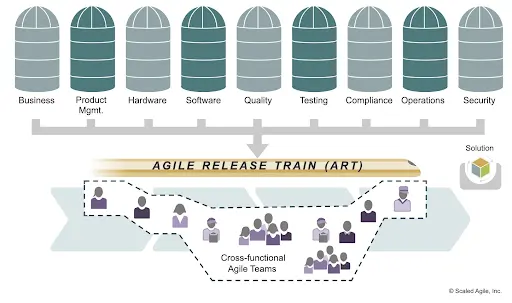Have you ever wondered how organizations can implement agile principles on a large scale?
More and more large organizations see the need to adjust faster to the ever changing market and customer needs. The issue for most of them is that they have complex products and hundreds or even thousands of employees working on them, which makes it hard to align all of these people and work efficiently.
Agile frameworks such as Scrum or Kanban are meant for single teams and don’t offer much cross-team collaboration. Therefore, those frameworks are usually not complex enough for large organizations.
Agile Release Train (ART), on the other hand, is a framework that provides exactly that for large organizations—cross-team collaboration, flexibility, fast product output, quick response times and a focus on the customer needs.
In this guide we’ll cover what exactly an Agile Release Train is, how it operates, what benefits it has, and how you can jump on board one.
Feel free to jump directly to any of the following topics:
- What is an Agile Release Train?
- What are Agile Release Train sync meetings?
- The importance of Agile Release Trains in product management
- How to create an Agile Release Train
- Agile release train FAQ
1. What is an agile release train?
Agile Release Train (ART) is a commonly used framework, which is part of the Scaled Agile Framework (SAFe). An ART is a cross-functional team that consists of several agile teams, which work in close alignment with each other.
This team of teams is self-organized, cross-functional and includes all the people necessary to autonomously make decisions. This makes an Agile Release Train extremely efficient and effectively removes functional silos.
One agile team consists of a Product Owner, a Scrum Master, and the development team, which includes roles such as software developers, testers, designers and business analysts. An agile team has 10 or less team members. One Agile Release Train consists of five to 12 teams, which amounts to a maximum of 50 to 125 people. ARTs are organized around a common business goal.
In addition to the aforementioned roles within each agile team, an ART also has a specific set of roles that are responsible for the whole entity. The Release Train Engineer takes care of all ART processes and facilitates ART events. They act like a Scrum Master for the ART.
Product management is responsible for what needs to be built—they create a vision and then a strategy to implement that vision. The System Architect is concerned with the technical architecture of what is being built. And the Business Owner is there to represent the business objectives.

2. What are Agile Release Train sync meetings?
Agile Release Train sync meetings are regular meetings throughout the program increment, where all agile teams of one ART come together to align on their progress and talk about any blockers or dependencies. Therefore, sync meetings show the members of the ART if they are still on the right track or if they need to adjust anything.
Depending on the size of the ART, it might be all people that come together or a smaller selection of people. The Release Train Engineer will facilitate the Agile Release Train sync meeting.
3. The importance of Agile Release Trains in product management
Agile Release Train, as a framework, is important for the product management of large organizations, which want to work in an agile way. Because the bigger an organization gets, the harder it will be to work in a fast, efficient and customer centric way.
ART offers better collaboration between teams, streamlined processes, predictable and consistent delivery of product increments, continuous customer feedback and increased transparency. It’s a comprehensive set of rules that touches upon all parts of the product development cycle and helps Product Managers work more efficiently.
Why use Agile Release Trains?
As a small startup, wanting to be agile is relatively easy to accomplish by using frameworks such as Scrum or Kanban. But when a large organization with complex product requirements decides to work more agile, it might want to use the Scaled Agile Framework, which uses Agile Release Trains to align several agile teams around one common business goal.
The framework provides a set of principles that, when executed well, creates collaboration between the teams, transparency and alignment, predictability because of incremental development and releases, and fast customer feedback.
Agile was initially not created for large-scale projects but Agile Release Trains make exactly that possible.
4. How to create an Agile Release Train
The first step to create an Agile Release Train is to decide on a business objective for it. Then teams need to be chosen for the ART. Here it’s important to make sure that the agile teams are cross-functional, meaning they have every role needed to make autonomous decisions throughout the product development process.
Product Management then needs to create a Program Backlog, which all teams work from. ART processes need to be established and events need to be scheduled. The Release Train Engineer will be responsible for everything process related.
When all of this is set up, the Agile Release Train is ready to begin its journey.
Agile Release Train best practices
It’s important for an Agile Release Train to have a shared vision as the basis of their work. Everyone involved should be aligned around that vision.
The Program Backlog, which is used by all agile teams within one ART, should be prioritized in a way that shows the highest value for customers at the top.
Releases should happen incrementally, which ensures fast output and thus also a quick response rate for customer feedback.
The teams should stay fully aligned by doing regular ART events, such as Agile Release Train sync meetings and Program Increment Plannings. This way the teams can stay on top of blockers and dependencies and it gives them room for collaboration.
Even though the Scaled Agile Framework has a comprehensive set of rules for ARTs to operate, there should always be a certain amount of flexibility, in order to adjust plans if necessary.
5. Agile release train FAQ
Now let’s have a look at the most commonly asked questions around Agile Release Trains:
What does release train mean?
The Agile Release Train is a virtual entity, a team of teams, that plans, develops, tests and releases product increments. A release, in this context, means the delivery of a part of the product, a new feature, for example, or an update to an existing feature.
These releases happen in continuous and even intervals, making it a predictable process. This process could be compared to a train that continuously and predictably moves to its destination, with some stops on the way. That is why it’s called “release train”.
What is the difference between Agile Release Train and Scrum?
Scrum is a framework within agile that is used to manage one team.
Agile Release Train, on the other hand, is a framework that is used to manage several agile teams that are working on the same topic. These teams work from one Program Backlog and towards a common business goal.
Each agile team within ART has the same roles as scrum teams have, namely a Product Owner, Scrum Master, and the development team. An ART has additional roles, such as Release Train Engineer, System Architect, Business Owner, and Product Management.
Both Scrum and ART work incrementally, but have different timeframes of these increments. A sprint in Scrum lasts one to four weeks and a Program Increment in ART lasts eight to 12 weeks.
What is release vs sprint in agile?
Within agile, a release is the delivery of a product increment, a piece of a product that has been developed and tested.
A sprint on the other hand is a concept within Scrum. It’s a set timeframe or timebox of one to four weeks, in which a scrum team does its dedicated work. Two week sprints are most common in Scrum.
6. Final thoughts
Operating an Agile Release Train can be highly efficient for building complex products and aligning many teams.
It’s important to note though that since ART is a complex product development framework, the implementation of it takes time and needs quite a bit of training. Thus, an organization needs to be willing to invest the resources necessary, in order to see any benefits.
If you want to know more about product management in general, check out CareerFoundry’s free product management short course, or take a look at the following guides:
